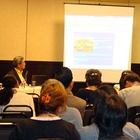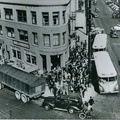Today, a number of challenges face the Japanese American communities in the United States. At the core of these challenges is the fact that Japanese American communities have become increasingly complex, dispersed and diverse. No longer can we neatly define the Japanese American community by generations – Issei, Nisei, Sansei -- who share common beliefs and historical experiences. Previous definitions of what constitutes a “Japanese American” now seem totally inadequate as one-out-of-three Japanese American is of mixed ethnic or racial heritage, and the new post-WWII immigration of “Shin Issei,” or “New Issei” born in Japan and their American-born Nisei children, have increased in numbers, especially in New York and Los Angeles.
By and large, this trend toward increasing cultural, ethnic and generational diversity is reflected in the U.S. population at large, especially since the Immigration Law of 1965 that lifted the discriminatory national origins quota that favored immigration from northern and western European nations. Today’s immigrants to the U.S. are coming in large numbers from Asia and Latin America and transnational migration and remigration are commonplace.
In 2004, the Census data reported that the Japanese Americans ranked sixth (832,039), behind the Chinese (2,829,627), Asian Indian (2,245,239), Filipino (2,148,227), Korean (1,251, 092) and Vietnamese (1,267,510), whereas in the1940s and ‘50s, the Japanese were once one of the largest and oldest Asian American groups in the U.S. Of this number over two-thirds of all Japanese Americans were born in the United States—the highest proportion among all Asian Pacific Americans. Most live in areas where Japanese immigrants first settled in late 19th century, i.e., over 60% live in California (34%) and Hawai`i (26%). The median age was slightly older than the U.S. population (Japanese Americans were 36.5 years in 1990; U.S. population was 33.0), and females made up 54% of the Japanese American population. And compared to the general population, Japanese Americans have a larger proportion of college graduates and a higher median income.
Into the 1990s, intermarriage rates continued to climb with 75% of young Japanese American adults marrying non-Japanese. As these intermarriage trends continue to rise, many portend the demise of the Japanese American community. Others argue that the future of the Japanese American community will depend on the inclusion of persons of mixed Japanese ancestry and on these mixed-ancestry Japanese Americans identifying themselves as such.
However, compared to the past, “identifying oneself as being Japanese American” or “being identified by others (or society) as Japanese American,” involves more ambiguity and options and less rigidity and restrictions. For example, during World War II all persons of Japanese ancestry living in the Pacific Coast States with as little as 1/8th Japanese blood were considered “the enemy,” whether American-born or not, and ordered to evacuate their homes, later to be imprisoned behind barbed wire without due process of law for the duration of the war.
Since the passage of the Walter-McCarren Act of 1952, Japanese are no longer classified as “aliens ineligible to citizenship” and younger generations have gained entry into prestigious universities, secured prominent positions, and many established residence in exclusive residential neighborhoods once reserved for “Whites Only.” Instead of combating Alien Land Laws, Presidential Directives, or Exclusion Orders like the generations before them, current generations of Japanese Americans are grappling with other kinds of issues related to greater self realization in their personal, professional, and community lives as they seek to define or redefine their place in American society, history and culture.
Faced with these changing characteristics of the Japanese American population, many members of Japanese American community situated in the East Coast and West are asking, “What is the future of the Japanese American community?” Twenty-to-thirty-years from now will there be a so-called “Japanese American Community,” and if one exists, “how will it be defined and constituted?” Will it be defined by a geographic “place” such as the current Little Tokyos and Japan Towns situated in San Francisco, Los Angeles, and San Jose? Will there be an existing body of people who identify themselves as “Japanese Americans” or would there always be a need to distinguish one as such? And if there is value to retaining the Japanese American community and its values, how do we nurture these future generations to continue the legacy of Americans of Japanese ancestry in the U.S? Or, will it suffice that the legacy of Japanese Americans be a footnote and lesson in American history with its current and incoming flows of peoples dispersed into the various structures and streams of American society? Or, is there a special ongoing “role of conscience” that Japanese Americans will always play in upholding the protection of civil liberties and justice for all people regardless of their gender, race, religion, and ethnicity?
As we stand at a threshold of the 21st Century, many in the Japanese American communities throughout the United States ask, “What can we do to honor and preserve the lessons, experiences, and legacy of the Nisei generation who are now in their 80s and 90s who struggled so hard to preserve civil liberties, freedom and justice”? And just as importantly, “What can we do to motivate and engage our current and future generations of ‘Japanese Americans’ to build upon the historical and cultural foundation established by the Nisei generation?” The questions raised by the rapid demographic changes in our populations are profound and the strategies employed to answer them will greatly shape the existence and future of the Japanese American community.
* The above article is the result of the debate that took place at that event at the round table “Current and historical questions in the Nikkei communities in the Americas,” in which Lili Kawamura took part, along with Célia Sakurai and Lili Kawamura.
© 2008 Akemi Kikumura Yano






